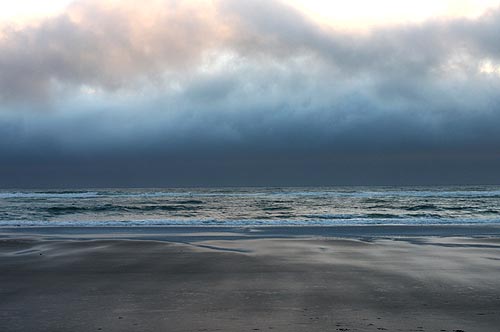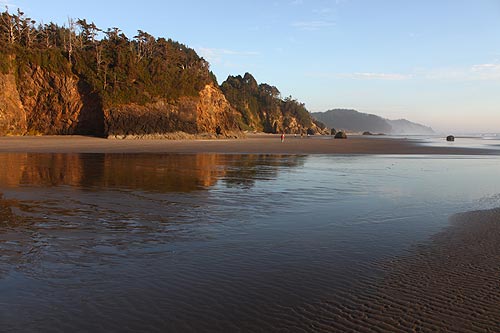Another Ocean Beneath the Oregon Coast? Maybe. Sort of
Published 06/15/2014

(Evanstan, Illinois) – The world is abuzz this week about a recent discovery made by researchers from Northwestern University and University of New Mexico that seems to indicate a large reservoir of water beneath the surface of the Earth – some 400 miles below. If the calculations are correct, the discovery made by Northwestern geophysicist Steve Jacobsen and University of New Mexico seismologist Brandon Schmandt means that there is almost literally another ocean down there, with a water mass perhaps three times larger than all the oceans on the surface.
However, before you invoke Jules Verne and start thinking about a surfing expedition to the center of the Earth, this is not a pool of water in the normal sense. Jacobsen and Schmandt are talking about a section of the Earth's crust where pressures are so high water does not exist in the usual forms we are familiar with, like liquid, ice or vapor. Instead, these are water molecules that exist in a state of being fused with the rocks at that depth.
Schmandt and Jacobsen used a network of over 2,000 seismometers positioned around North America – along with a variety of lab experiments. While not an ocean in the literal sense, it seems to mean there is this ocean-like layer beneath the continent, if not the world – and that would include underneath the Oregon coast and the Pacific Ocean.
“The water cycle involves more than just the water that circulates between the atmosphere, oceans, and surface waters,” said the journal Science, describing the findings. “It extends deep into Earth's interior as the oceanic crust subducts, or slides, under adjoining plates of crust and sinks into the mantle, carrying water with it.”
This find sheds more light on how water gets cycled through the Earth and beneath the tectonic plates. Scientists have been looking for this deep - very deep - H20 for decades, having long speculated water exists in large masses in the zone between the upper mantle and lower mantle.
All this could have some impact on theories of how the Earth was formed, including the theory that much of the planet's water came from icy comet impacts.
The water molecules are locked up tight in a mineral called ringwoodite that exists in what is called the “transition” zone between the two mantles. The presence of water was strongly suggested by the fact there is magma – melting rock – in that zone, according to the group's findings. Pressures are so great at that depth that the presence of water molecules would cause the rock to melt to some degree, a process that also squeezes the water out of the rock and sends it elsewhere in or on the Earth.
Jacobsen also theorized this layer of trapped water may help explain why oceans stay the same for millions of years at a time. With so much water present on the Earth, if some of it wasn't trapped beneath the surface, the oceans would be high enough to leave only mountaintops poking out of the seas.
In 2007, another group of researchers found a massive resevoir beneath Asia, and others found more evidence beneath Canada last year.
More on Oregon coast science.
More About Oregon Coast hotels, lodging.....
More About Oregon Coast Restaurants, Dining.....
LATEST Related Oregon Coast Articles
One was a rare orca find; both suspected human interaction. Marine sciences
N. Oregon Coast's 'Cheese War' a Quiet Part of Tillamook-Area History: See th...
History talk in Nehalem on April 26 about Tillamook battles. Manzanita events, Cannon Beach events, Tillamook events
Lyrid Meteors with a Possible Side of Aurora for Washington, Oregon, Coastlines
Lyrids peak on Monday, northern lights possible northern Washington. Weather
Road Work Coming to North Oregon Coast's Gearhart and One of World's Largest ...
Lane closures this summer on the bridge; major work in Gearhart next year. Washington coast
Be Jeweled Returns to Central Oregon Coast, Newport's Dazzling, Arty Jewelry ...
Saturday, May 10, from 10 AM to 4 PM featuring more than 2,000 pieces. Newport events
N. Oregon Coast Bridge Work During Travel Season: Some Traffic Delays on Asto...
Occasional one-lane traffic from June through September at Astoria / Ilwaco. Washington coast
Cape Kiwanda's Colossal Sand Dune: Wild Oregon Coast Rides and How It's Changing
A mix of crazy recreation with science of a crumbling landmark. Sciences, Pacific City, Oceanside
Oregon Coast, Valley and Likely Washington Coast to Get Some Aurora Borealis ...
Likely just before dawn best hour but peak happens during daylight. Weather
Back to Oregon Coast
Contact Advertise on BeachConnection.net
All Content, unless otherwise attributed, copyright BeachConnection.net Unauthorized use or publication is not permitted

















































